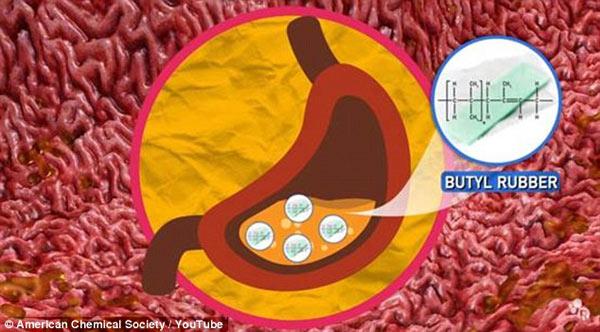双语阅读:口香糖粘肠子?其实可被排出体外
【来源:易教网 更新时间:2018-06-21】

It is a classic playground scare story - if you swallow chewing gum it will stay in your digestive system for seven years.
有个经典的大人拿来吓唬小孩的谎言——如果你吞下了口香糖,它将在你的消化系统里停留七年。
But according to scientists at the American Chemical Society, the tale is myth as chewing gum is no more harmful than the rest of the food that passes through our digestive system.
但是据美国化学学会的科学家称,这并非事实,其实嚼过的口香糖和其他经过我们肠胃的食物一样,没有什么危害。
It says while gum is harder to digest, it tends to pass harmlessly through our guts much like other foods.
研究发现,虽然口香糖很难消化,但是它和其它食物一样,都能从肠道无害排出。
By examining how regular foods are processed through our bodies, a video from The American Chemical Society reveals what really happens when you swallow chewing gum.
通过研究我们的身体如何消化吸收普通食物,美国化学学会制作了一段视频,向大家展示了当你吞下口香糖,肠胃里会发生什么情况。
When we eat something - whether it be normal foods or chewing gum - it goes through three main phases in our bodies.
当我们进食时——不管是正常的食物还是口香糖——都会在消化道内经历三个主要阶段:
The first of these phases is the 'mechanical' phase (otherwise known as chewing).
第一阶段是“机械”阶段(也就是咀嚼)。
As the Reactions video explains, with normal foods 'your teeth and tongue work together to crush the food you eat into tiny bits.'
正如这个“反应视频”所解释的那样,进食普通食物时,你的牙齿和舌头协同工作,将你吃进去的食物嚼成小小的碎末。
Munching your food then triggers muscle movements which move the food through your digestive tract down to your stomach, where muscles 'churn your chewed up food with digestive juices.'
用力咀嚼食物带动肌肉运动,这会把食物通过食道运送到胃里,胃部肌肉“用胃酸搅拌你咀嚼过的食物”。
The second phase involves enzymes - biological catalysts which speed up chemical reactions - which are found in your saliva, stomach juices and intestines.
第二阶段涉及到酶,这是一种可以加速化学反应的生物催化剂。这些消化酶主要存在于唾液、胃液和小肠液中。
Enzymes 'kick start' the reactions to break down the food into its constituent parts, whether they are fats from foods such as cheese, carbohydrates from food such as pasta, or proteins from meat or nuts.
酶能“启动”这些反应,将食物分解为一些基本成分,比如从奶酪里分解出脂肪,从意大利面里分解出碳水化合物,或者从肉类、坚果类分解出蛋白质。
These constituent parts are the nutrients your body can use.
这些成分就是人体可以利用的营养物质。

Stomach acid, which is made up of hydrochloric acid and salts, leads the third phase of digestion.
第三个消化阶段由胃酸引导。胃酸由盐酸和盐分组成。
The video explains 'this harsh brew dissolves chewed food into a slurry so your intestines can handle it'.
视频解释说,“这种非常厉害的消化液可以把咀嚼过的食物分解为泥浆状,这样你的肠道就可以处理它们了。”
After this point, whatever remains goes straight down the toilet.
经过此步之后,剩下的东西就以粪便形式被排出体外。
How does your body process chewing gum?
那么身体又是如何处理口香糖的呢?
As you'll have probably noticed, the main difference when processing chewing gum is the fact that during the 'mechanical phase' you don't crush the chewing gum down into tiny bits - that would somewhat defeat the purpose of chewing gum.
可能你已经注意到了,处理口香糖,和其他食物最大的不同就在“机械”阶段,口香糖不能被分解成小块——如果真的嚼碎了,一定程度上就没有达到吃口香糖的目的。
Instead, if you swallow the gum, it will go down in one big wad before it enters phase two - the enzyme phase.
因此,如果你将它吞下去了,它就会整个一大团直接进入第二阶段——酶消化阶段。
Most of the molecules in gum are carbohydrates, oils and alcohols. As with any other food, on their own these molecules are easily broken down.
口香糖里的主要成分是碳水化合物、油类和醇类。与其他食物一样,仅仅是这些分子的话,它们很容易分解。
However, the video explains 'your body doesn't have an enzyme for the rubber polymers, regardless of whether they're natural or synthetic' so the gum passes through to Phase three. While stomach acid is strong, it still can't dissolve the rubber polymers in the chewing gum.
然而,视频解释说,“你的身体里没有能分解橡胶聚合物的酶类,不管是天然的还是合成的。”所以,口香糖来到了第三个阶段。尽管胃酸很强大,但它仍然不能分解口香糖中的橡胶聚合物。
In fact, the video explains 'rubbers are very good at shielding from acids in general - that's one reason we wear rubber gloves for protection.'
事实上,视频解释说,“一般来说,橡胶的防酸特性非常好,因此我们戴橡胶手套进行保护”。
So, while part of your gum does survive digestion, it does not remain in your stomach for seven years.
所以,尽管口香糖的部分物质确实在消化系统中幸存下来,但它却不会在肠道中呆上7年。
The video concludes 'even though you don't break down the rubber polymers, your body has no problem moving that lump of gum through your digestive system and out the other end within a day or two.'
视频最后总结说,“尽管橡胶聚合物没能被分解,但你的身体也完全可以把这一团口香糖清除出消化系统,‘这头进那头出’,只要一两天时间。”
- 沈教员 江苏第二师范学院 计算机科学与技术
- 李教员 南京晓庄学院 计算机
- 王教员 南京航空航天大学 机器人工程
- 王教员 南京大学 计算机
- 单教员 南京大学 法律
- 任教员 南京工业大学 交通工程
- 尤教员 南京财经大学 会计
- 林教员 湖北大学 数字媒体艺术
- 音教员 西安理工大学 光电

 搜索教员
搜索教员
